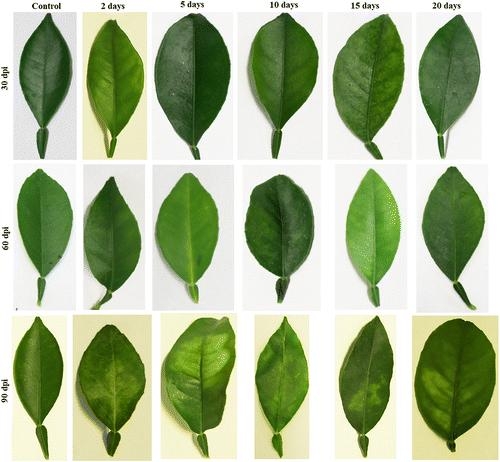Citrus Huanglongbing (HLB), also known as greening, is one of the most serious citrus plant diseases in the world. Infected trees produce bitter fruits that are green, misshapen, and unsuitable for sale. Once a tree is infected, there is no cure and it typically dies within a few years. Greening has already devastated the Florida citrus industry and poses a threat to California and Texas as well as Australia and the Mediterranean region.
Currently the most effective ways to prevent the spread of HLB are to stop the causal agent (Candidatus Liberibacter asiaticus) using quarantine measures, control the insect that spreads the disease (Asian citrus psyllid), remove the diseased trees, and plant HLB free trees. To this end, early diagnosis of HLB-diseased trees is crucial. Traditionally, diagnosis relies on observing blotchy mottle symptoms and confirming disease presence using molecular tools. However, these symptoms do not show until months after disease transmission and by then the disease has likely already spread throughout the grove.
Professor Nian Wang and his postdoctoral research associate Dr. Sheo Shanker Pandey, both from Citrus Research and Education Center, Department of Microbiology and Cell Science, at the Institute of Food and Agricultural Sciences of University of Florida, developed a strategy for early diagnosis of HLB before the appearance of blotchy mottle symptoms. They used a low-cost staining method to identify insect feeding sites and tested those identified sites for the causal agent using quantitative real-time PCR (polymerase chain reaction).
Through this method, the pair were able to detect the HLB causal agent up to two days after transmission and long before the appearance of symptoms. This early detection will enable citrus growers to prevent the spread of HLB in their fields. This finding is especially crucial for California, Texas, Australia, and the Mediterranean region as those areas are currently plagued by HLB.
###
More details about this study can be found in "Targeted Early Detection of Citrus Huanglongbing Causal Agent 'Candidatus Liberibacter asiaticus' Before Symptom Expression" in Phytopathology Volume 109, Number 6, published June 2019.
https://apsjournals.apsnet.org/doi/full/10.1094/PHYTO-11-18-0432-R
The appearance of HLB symptoms in 5-month-old cultivar Valencia seedlings fed by Asian citrus psyllid for 2 to 20 days. The HLB symptoms were monitored at 30, 60, and 90 days postinoculation (dpi). Representative images of HLB symptom development are shown. Photo: Sheo Shankar Pandey and Nian Wang
Attached Images:
